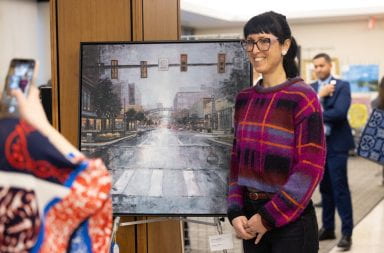
Kevin McClatchy, as Prospero, and Greg Hicks, as Caliban, in ”The Tempest.” Credit: Courtesy of JiRye Lee
The works of William Shakespeare have long been studied for their depth, rhythm and progressiveness, but more recently, actors at Ohio State are using them for drama therapy.
Since 2012, the Shakespeare and Autism Project at OSU has worked with children on the autism spectrum using Shakespeare’s “The Tempest.” Actors create games inspired by “The Tempest” and teach them to the children in order to encourage social skills and establish personal connections.
This particular method of drama therapy, called the Hunter Heartbeat Method, was developed by Kelly Hunter, a British actress and director, in the early 2000s. Hunter first used Shakespeare as a rehabilitation method for prison inmates in England, but once she saw that it was successful, she adapted her method to help children on the autism spectrum, said Kevin McClatchy, an assistant professor of theater.
Hunter is an ensemble actor with the Royal Shakespeare Company, which partners with the university, and she brought the Hunter Heartbeat Method to the OSU Department of Theatre and the Nisonger Center in 2011.
A core team of teaching artists, spearheaded by Robin Post, a former visiting assistant professor, visited a Columbus elementary and middle school for two years to work with children with autism. The Nisonger Center tested these children before, during and after the drama therapy, and released the results of its research in May 2015.
“Their research was encouraging in the sense that there was statistically significant improvement in certain targeted areas,” McClatchy said. “For example, social use of language, facial recognition and eye contact.”
Parents, teachers, and caregivers reported significant behavioral improvements, suggesting more than a statistical improvement, McClatchy said. Some parents, who believed their child to be nonverbal, saw their child speaking lines during the games and performances.
Elizabeth Girvin, a third-year in psychology and theatre, said she was initially interested in the program because her older brother is on the autism spectrum. She said she believes the games are highly beneficial to the children.
“They are heartwarming and fun and active,” Girvin said. “You can see how for kids on the autism spectrum, who struggle making connections with others, it can be a beautiful thing.”
Girvin is one of eight students in the Shakespeare and Autism course, which has been offered at OSU since fall 2013. The course trains students to be teaching actors before they travel to the Nisonger Center, where they help conduct workshops with the children.
While there is no such thing as a typical workshop, McClatchy said each one begins with the Heartbeat Hello. During the Heartbeat Hello, both the children and actors tap out a heartbeat on their chests and greet one another in synchronization. McClatchy said the Heartbeat Hello is a transition into the world of Shakespeare and the games.
“It is a gateway into playing games because it is directly related to Shakespeare’s language, the iambic pentameter, which has the comforting rhythm of a heartbeat,” McClatchy said.
Girvin said her favorite game is Oh You Wonder. During this game, one boy plays Ferdinand from “The Tempest” and one girl plays Miranda. Ferdinand chases Miranda and when they make eye contact, Ferdinand makes a silly noise and turns his fingers into pretend glasses, and Miranda runs away, embarrassed. Girvin said the children do this two to three times, but on the final time, instead of making a silly noise, each child says,“I love you.”
“The biggest take away for anyone to learn is that individuals on the autism spectrum can learn, and they can love very well. They just don’t know how to express it, but this program helps them to do so,” Girvin said.
The annual capstone production of Shakespeare and Autism is a performance of “The Tempest,” in which both actors and children play roles. The first capstone production was performed in Stratford-upon-Avon, England, and was directed by Kelly Hunter. Now they continually take place at OSU.
“(The production) heightens the workshop experience and it turns it into a theatrical event where the story is told with these incredible games,” McClatchy said.
Most performances have the dual purpose of securing grants; the most recent donor being Patricia Heaton, an OSU alumna and actress from ABC’s “The Middle.”
McClatchy said she hopes the program continues to gain support so the Hunter Heartbeat Method can expand.
“Our ultimate goal is to ripple the work out as far and wide as possible,” McClatchy said. “To continually have teaching artists who work all over the U.S. doing workshops and engaging and helping as many children with autism as possible.”


